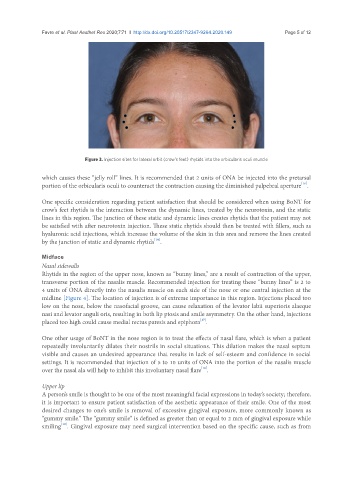Page 843 - Read Online
P. 843
Favre et al. Plast Aesthet Res 2020;7:71 I http://dx.doi.org/10.20517/2347-9264.2020.149 Page 5 of 12
Figure 3. Injection sites for lateral orbit (crow’s feet) rhytids into the orbicularis oculi muscle
which causes these “jelly roll” lines. It is recommended that 2 units of ONA be injected into the pretarsal
[16]
portion of the orbicularis oculi to counteract the contraction causing the diminished palpebral aperture .
One specific consideration regarding patient satisfaction that should be considered when using BoNT for
crow’s feet rhytids is the interaction between the dynamic lines, treated by the neurotoxin, and the static
lines in this region. The junction of these static and dynamic lines creates rhytids that the patient may not
be satisfied with after neurotoxin injection. These static rhytids should then be treated with fillers, such as
hyaluronic acid injections, which increase the volume of the skin in this area and remove the lines created
by the junction of static and dynamic rhytids .
[10]
Midface
Nasal sidewalls
Rhytids in the region of the upper nose, known as “bunny lines,” are a result of contraction of the upper,
transverse portion of the nasalis muscle. Recommended injection for treating these “bunny lines” is 2 to
4 units of ONA directly into the nasalis muscle on each side of the nose or one central injection at the
midline [Figure 4]. The location of injection is of extreme importance in this region. Injections placed too
low on the nose, below the nasofacial groove, can cause relaxation of the levator labii superioris alaeque
nasi and levator anguli oris, resulting in both lip ptosis and smile asymmetry. On the other hand, injections
[17]
placed too high could cause medial rectus paresis and epiphora .
One other usage of BoNT in the nose region is to treat the effects of nasal flare, which is when a patient
repeatedly involuntarily dilates their nostrils in social situations. This dilation makes the nasal septum
visible and causes an undesired appearance that results in lack of self-esteem and confidence in social
settings. It is recommended that injection of 5 to 10 units of ONA into the portion of the nasalis muscle
[16]
over the nasal ala will help to inhibit this involuntary nasal flare .
Upper lip
A person’s smile is thought to be one of the most meaningful facial expressions in today’s society; therefore,
it is important to ensure patient satisfaction of the aesthetic appearance of their smile. One of the most
desired changes to one’s smile is removal of excessive gingival exposure, more commonly known as
“gummy smile.” The “gummy smile” is defined as greater than or equal to 2 mm of gingival exposure while
[18]
smiling . Gingival exposure may need surgical intervention based on the specific cause, such as from

